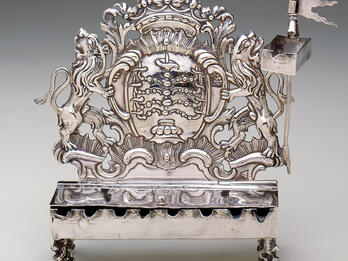Huppah
Artist Unknown
1748

The traditional Jewish marriage contract, signed during the wedding ceremony, defines marriage as the husband’s acquisition of his wife. Note how the woman’s face remains covered by her future husband’s prayer shawl. This prevents the viewer from seeing the face of the bride and gaining any insight into her experience of the ceremony. There is also a clear separation of men and women, with a male figure officiating at the marriage. Aspects of this depiction, such as the clothing worn by the attendees, reveal early signs of modernity’s influence on Jewish culture that would ultimately challenge gender norms and reshape the Jewish wedding in some streams of Jewish practice.
What aspects of this eighteenth-century Jewish wedding might you expect to see in a modern wedding ceremony?
Can you find the wedding/marriage stone in this image (look near the right corner of the huppah.) What do you think this stone (called Treustein in German) might have been used for?
If we could see the bride’s face in the image, how do you imagine it would be depicted?
Related Guide
Material Culture and Modernity
Discover the many types of objects—furnishings and clothing, jewels and medals, wares—crafted by Jews or specifically for use by Jews.
You may also like

Gender Roles
Engage with the gendered dimensions of Jewish life and discover lost voices of Jewish women.

Inventory of Household Goods of Nathan Levy

Ketubah (Rome)

Snuff Box

Torah Shield (Piotrków)


